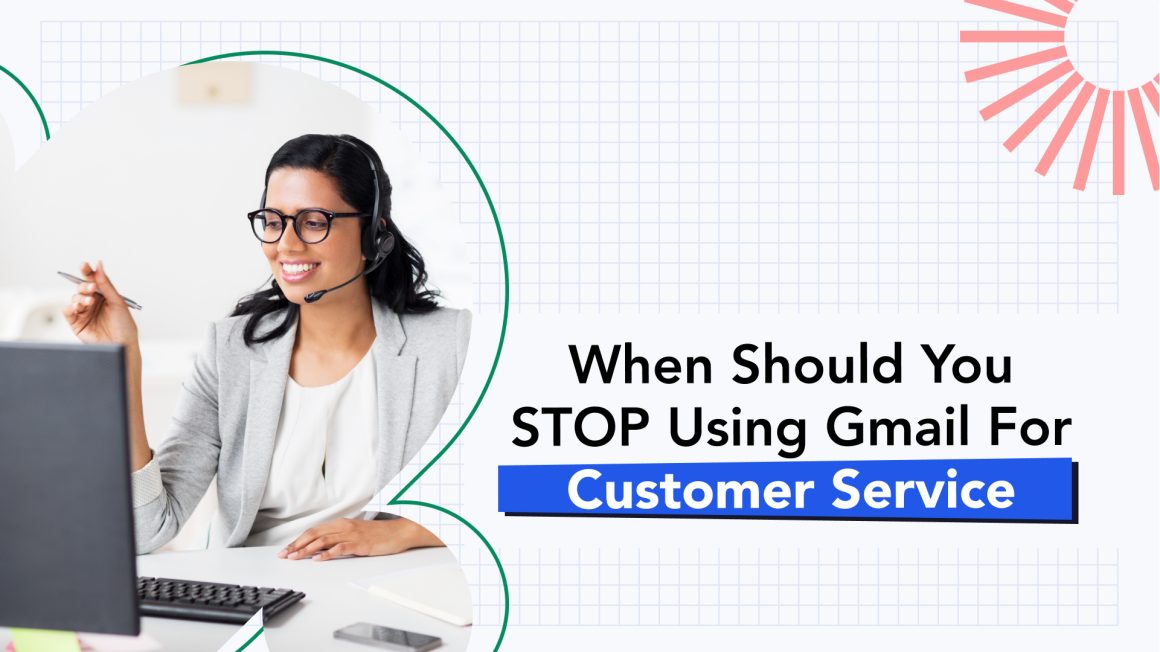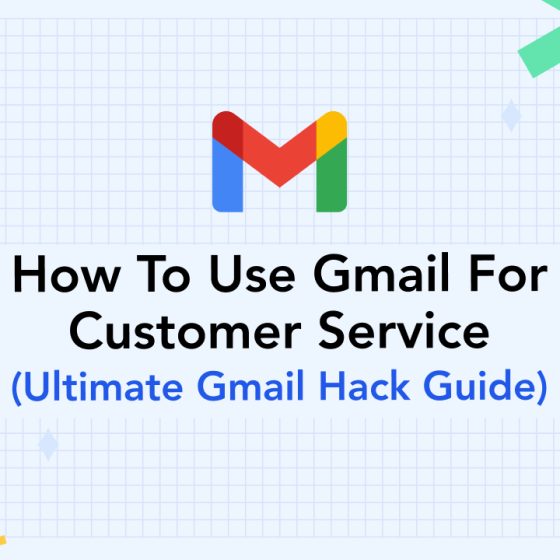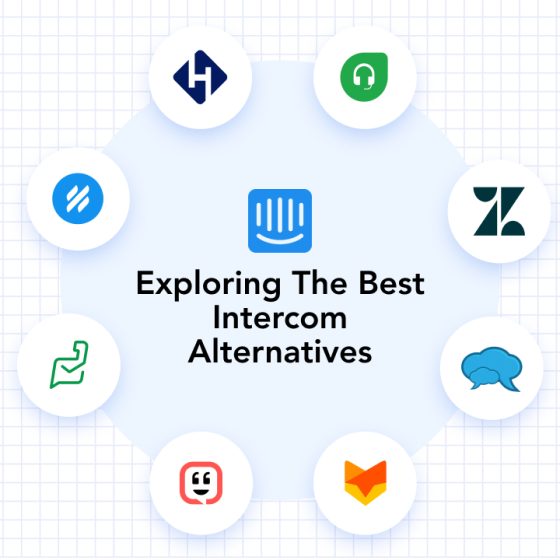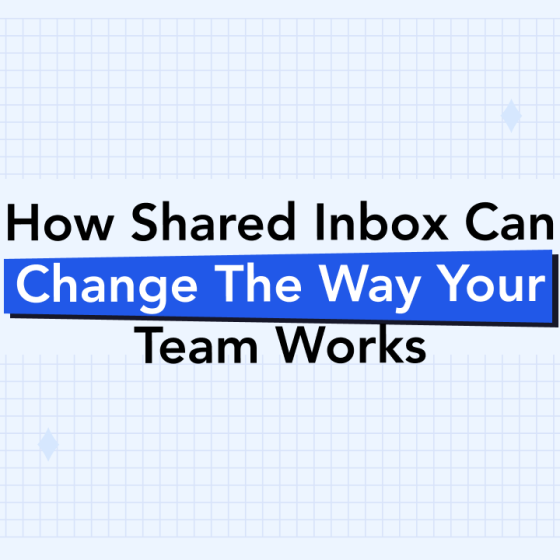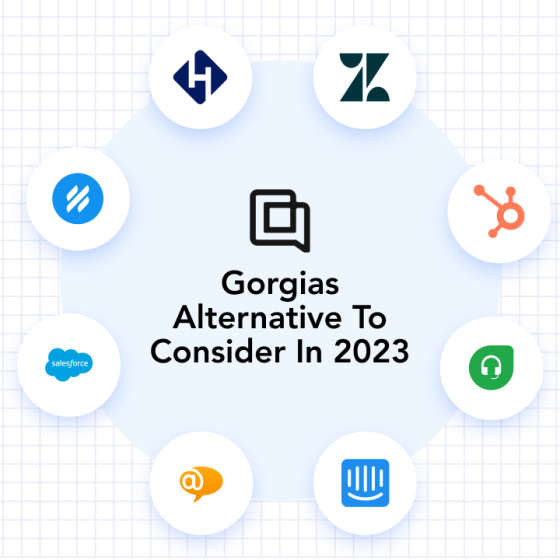Does your business use a shared Gmail account to run operations? Perhaps a big “yes” if you are a startup or a customer service organization. Indeed, every 9 out of 10 startups is a Gmail customer. In addition, 60% of mid-scale companies prefer Gmail to their own dedicated email domains or a different service provider.
As a customer service leader, your regular operations hover around Gmail shared inboxes. When your business is in its early days, a simple, no-cost collaborative inbox solution will cut the mustard owing to low query inflow.
However, as your business expands, there are imminent trade-offs, including a cluttered and jam-packed Gmail shared inbox.
When drowned with innumerable and complex requests, your agents will likely ignore some of them or provide unsatisfactory solutions. Even more hilarious, they could give irrelevant responses out of confusion.
“Customer: Hello, I’m facing issues with using the XYZ feature of your product.”
Customer service agent: Hello, sir/mam. Thank you for buying from us. We hope you’re having a great experience with our product.
Customer: 😐 😐”
So, is there a better alternative to better handle customer tickets?
Of course, and it is a customer service software.
Read on to know why and how migrating to a customer service solution from Google Groups is a wise decision.
Benefits of Gmail for Customer Communication
Customer service organizations using Gmail experience the following benefits:
1. People are Well-versed in Gmail
With around 2 billion active users, Gmail is the leading email provider across continents. Based on this statistic, it is safe to say that you are already using Gmail for personal reasons, and are also considering using a shared Gmail account for your customer service business too.
Similarly, if you instruct your agents to use Gmail shared mailboxes to manage customer support emails, chances are they need not have to learn a new productivity tool. The average customer service representative is already likely accustomed to Gmail’s user interface (UI) and does not need any training to set in motion.
Furthermore, new recruits can start using Gmail right off the bat and reduce the time required to reach maximum efficiency.
2. Goes Along Well with Other Google Tools
Gmail is a subset of Google Workspace (earlier G-suite) and plays nicely with other applications. Just log in/sign up for Gmail to access the entire Google Workspace toolkit.
For instance, Google Chat allows for one-on-one or group chats with agents. Similarly, you can join Google Tasks to create to-do lists, set deadlines, and tick off completed tasks. Further, Google Forms lets you collect feedback and insights through personalized surveys.
3. Easy on the Pocket
The basic Google Workspace package (Business Starter) that includes Gmail starts from just US$6/year. Add more tools and features to enjoy Business Standard (US$12/year) and Business Plus (US$18/year) plans. All these pricings are per user, per month.
While you can find various cheaper collaborative inbox service providers, Google Workspace provides a lot with a huge bang for your buck. That is a pretty excellent deal and a no-brainer.
Startups or small-scale establishments with a handful of agents can find Gmail significantly cost-effective.
Why is Gmail not a Suitable Tool for Boosting Customer Service and Agent Performance?
Customer service firms stumble upon the following problems when using Gmail shared inbox services:
01. Leads to Agent Collision
With shared Gmail accounts, you can create a workflow, use color-coded tags, or build elaborate folders to manage customer service operations. Also, the collaborative inbox tool lets your agents tag each other, bringing some order to the process.
However, these actions are manual and unrecorded. Moreover, you also risk customer service agents unintentionally stepping on each other’s toes. As such, your staff might work on the same request without each other’s notice.
The absence of a concrete query tracking system causes agents to initiate numerous customer-facing conversation. Things can go further downhill when the solutions or information offered by each support agent differ, confusing customers.
02. Does Not Support Omnichannel Communication
Today, customer service is no longer restricted to phone calls, emails, and messaging. Your clients might contact you via live chats, social media platforms, and instant messaging. Simply put, they want to interact with you and/or your agents through their preferred communication mode.
Sadly, Gmail shared mailboxes have no facility to avoid duplication of support requests initiated across multiple channels.
This results in poor response times, orphaned responses, and inadequate contextual support at all touchpoints. Additionally, switching between channels is time-intensive and, worse, causes difficulty keeping pace with customer communications scattered across channels.
03. No Analytics Tool
All organizations house tons of customer service information, but only a few know how to tease out the relevant customer metrics. Extracting crucial information is tricky without solid analytics, and Gmail shared inbox does not have a built-in one.
It leans heavily on various third-party apps to derive insights, such as agent response rate, ticket volume trends, and customer satisfaction. However, if you regularly use products – Outlook Calendar or Microsoft SkyDrive – integrating these services with Gmail will compound the complexity depending on your workflow.
Moreover, chances are the integration can go awry, which can bring headaches later on.
04. Inefficient Collaboration
Customer service cannot function in silos. To fix issues, you must collaborate with various internal stakeholders and third-party apps to conjure up the right solution. Complementing customer service with tools that drive frictionless collaboration is especially vital in the “work from anywhere” era.
Unfortunately, with Gmail shared inboxes, you have to communicate offline every time your agents need help with a tricky situation or need approvals from a different function. The entire process is draining and leads to operational inefficiency.
Signs that Gmail is no Longer Meeting Your Customer Service Needs
If these hypothetical scenarios are your reality, it is high time to rise above Gmail shared inbox:
01. Monitoring Customer Queries Becomes Difficult
Every agent receives enough number of customer service emails on repetitive problems. Not to mention the time required to categorize the emails into particular folders based on the nature of the issues.
Though Gmail shared inbox solutions offer filter options to help you sift through customer problems, you will risk critical issues slipping through the cracks. To whom those tickets get transferred remains a mystery with Gmail, no matter how complicated your workflow is.
If you cannot separate urgent support requests from not-so-important ones, it is time to bid goodbye to Gmail.
02. Slow Response Times
If your customer base expands, you have to toil hard to monitor the rising requests and responses. An ever-growing Gmail inbox makes sorting and filtering customer support emails challenging. Sooner or later, you will be tangled in a vicious cycle where the number of customer emails far exceeds those you can address.
As such, your response time takes a huge hit, thus impeding customer satisfaction.
03. Frequent Communication Loopholes
Customer service has branched out to multiple channels. Whether phone, email, social media, or chat, your agents must address customers approaching through different channels.
However, toggling between multiple tools, including Gmail shared inbox, live chat, and social media channels, hinders time efficiency and customer satisfaction. Plus, customer-facing interactions get scattered across these tools; hence, keeping up with them becomes daunting.
Such frequent miscommunications are an indicator of the need to move away from Gmail.
04. Overwhelmed Support Agents
Your customer service agents are crippled without the tools necessary to handle incoming requests. They find it frustrating to get various similar queries and offer the same response.
As mentioned, customers reach out via multiple communication channels, not those you offer. For instance, they might ping you via a tweet and then email you some additional insights.
As such, your customer service agents grapple with connecting the dots and providing a seamless experience or a rapid response. The result of the agent workload: overworked and overstressed staff who burn out faster and perform worse. Eventually, customer service takes a hard hit.
Top Gmail Alternatives for Customer Service in 2023
Here is a handpicked list of the best Google Groups alternatives:
01. Helpwise
Helpwise is the best collaborative inbox solution that collects customer queries/issues across multiple channels in one platform. As such, brands can achieve “inbox zero” – where each query is responded to and handled every single day. Plus, in-built automation tools help agents cut down response times.
Pros:
✅At-scale personalization
✅24/7 support system
✅Auto-assign queries to agents
✅Offers in-depth insights, including query volume, response times, and customer satisfaction scores
✅Categorize crucial emails to find relevant conversations easily
Cons:
❌Helpwise works great but could do better with more app integrations
❌The alerts on an iPhone could also be better
02. Front
Front is designed to help businesses manage make-or-break customer-facing interactions. It integrates all communications by storing external and internal messages in a centralized hub.
Pros:
✅One-click conference scheduling
✅Intelligent email tracking
✅Shared inbox wards off the need for tickets
✅All plans include multi-channel messaging
Cons:
❌Each plan includes a minimum number of users
❌Inability to search emails by the body text
❌Plugin is confusing to use
03. Help Scout
Help Scout is ideal for businesses seeking customer service software that is easy to install and does not demand much training. Moreover, its software is packed with in-built reports to help brands monitor their agents’ performance from day one.
Pros:
✅Fast onboarding of new users
✅HIPAA compliance
✅Special plans for startups and non-profits
Cons:
❌No free options
❌Not many integrations compared to competitors
❌Limited customization
❌High-priced messaging feature
04. Gladly
Gladly helps businesses provide at-scale personalized customer service across various channels – text, voice, chat, and email. Combined with any third-party tool, it gathers the context of the communication and conveys the same to agents.
Pros:
✅User-friendly layout and design
Cons:
❌Inability to use external signatures
❌Generating per-hour reporting is difficult
❌Freezes when you open multiple tabs
05. Hiver
Hiver is designed to work with Gmail to enable brands to manage customer service communications in a single place. You can monitor internal emails and tasks, access reporting to better understand agents’ performance, and gain insights into customer-facing conversations.
Pros:
✅Unlimited tags and shared inboxes
✅Rapid onboarding Round-the-clock email and chat support
Cons:
❌Fewer integrations compared to peers
❌No separate folders for sent emails
❌Insufficient draft sharing
❌Not value for money
| Name | Key Features | Pricing |
| 1. Helpwise | Separate log-ins AI chatbot Multi-channel communication support Automated workflows Real-time analytics Integrations with native and third-party tools | Standard plan (US$15/user/month) Premium plan (US$25/user/month) Advanced plan (US$50/user/month) Enterprise (on request) |
| 2. Front | Automation Live chat Multi-channel management CRM integrations Real-time analytics and reporting Knowledge base | Growth plan (US$49/user/month) Scale plan (US$99/user/month) Premier plan (US$229/user/month) |
| 3. Help Scout | Reporting and analytics Live chat Automated workflows CRM integrations Self-service options Shared inboxes | Standard plan (US$20/user/month) Plus plan (US$40/user/month) Pro plan (US$65/user/month) |
| 4. Gladly | Call routing Automated responses CRM integrations Reporting/Analytics Live chat | Hero plan (US$ 150/user/month) Super Hero plan (US$ 180/user/month) |
| 5. Hiver | Live chat Third-party and native integrations Personalized responses Automation Reporting Multi-channel support | Lite plan (US$ 15/user/month) Pro plan (US$ 39/user/month) Elite plan (US$ 59/user/month) |
How to Switch from Gmail to a Customer Service Platform
When considering switching from Gmail or any other customer service platform, prepare well in advance before kick-starting the process. Similar to any large-scale project, you need a blueprint that will not hamper your customer service.
Here are five steps to ensure a seamless transition from Gmail shared inbox to a more robust customer service software:
01. Pick the Suitable Customer Service Platform
The first step toward migration is locking in the right customer service platform. For that, you must determine your goals and requirements. Later on, create a checklist while searching for the ideal solution that includes the following:
- Automation, including canned responses, chatbots, auto-scheduling, auto-routing, and query management
- Integrations with prominent platforms – Zapier, Hubspot, Slack, and JustCall
- Support for omnichannel communications
- Pricing comparisons between multiple options
- Reading online reviews of active users to get the real scoop on the “filtered-out” platforms
Apart from these, the best email platform for small businesses comes with a product demo or free trial.
02. Get your Agents On board
Moving from a shared mailbox management software to a customer service platform is a tremendous change. To drive this transition smoothly, you need all your agents to be on the same page. So, before digging into the technicalities, explain the goals and intentions fueling this transformational change, the potential benefits, and the impact on everyone.
Conveying the vision to your agents and how the new customer service software complements their work will keep them in high spirits throughout the migration. To sum up:
- Analyze the pain points of the current customer support system
- Elaborate on how the new business application will help eradicate those issues
- Show what possible advantages you are staring at down the road with this new application
For larger support staff, ask your most vocal agents to advocate the transition from collaborative inbox solutions to customer service software.
03. Make them Comfortable with the New Application
As the transition date knocks on the door, grant your team access to the new customer service platform (test account) to become familiar to the interface.
Organize thorough training sessions, offering your agents a live walkthrough of customer service software. Educate them about its multiple functionalities and answer any questions that they could have about deploying the tool and getting started.
Besides, a video walkthrough or screen-share is another effective way to cover considerable changes with your customer service agents. Case in point:
“Rather than tagging conversations to ‘pending,’ we label them to ‘closed’ now.”
“What we used to call a ticket is now called a conversation.”
“We’ve split customer queries into different folders/labels, which you can find here and here.”
04. Map out Data Migration
Do you want to import some or all of your customer service history into the new application? The sooner you devise your data migration roadmap, the more time you have to prepare for the switchover.
Consider these factors while migrating data:
- The quantity of data you have to move. Small data chunks are simpler to manage
- How well organized is your data? If the answer is in the negative, better start afresh and not stake all your future analytics and reporting
- Ongoing access to the old data in the existing shared Gmail account
- Whether the existing system contains APIs to export your data
- Whether the new customer service platform can automatically import and categorize the data
05. Set up your Workflows
After switching to the customer service software, you will still have conversations saved in the existing collaborative inbox system that started before the migration.
If you are already done with your data migration, a small stack of customer-facing conversations might miss the migration and, hence, reside in the old setup.
So, refer to your “time to resolution” to determine how long those conversations usually continue. You might need another (small) migration a week or two after the major switchover to restore the remaining conversations.
Gmail Out, Better Customer Service In
Customer service is a critical component of most businesses – it is what sets you apart from your peers.
Even though Gmail shared mailbox is considerably popular across continents, it is a silent killer when it comes to collaborating with your agents on critical matters or solving customer issues.
Let’s face it, shared Gmail accounts lack advanced support features and are not designed for team collaboration. Not surprisingly, C-suites globally are encountering reduced productivity, ticket overflows, and increasing frustration.
Today, Gmail is fading away, and customer service platforms are replacing them.
With customer support software, you do not need to reinvent the wheel. Your agents can share canned responses to similar customer problems, enjoy automated workflows, and gain deeper insights into conversations.
So, are you ready to make a big leap from Gmail shared inbox to a customer service platform?
Sign up for a 14-day free trial with Helpwise to offer flawless customer service 24/7.
Check out our next article on shared inbox solutions.
FAQs
Q. Why do brands prefer Gmail for customer service?
Customer service businesses use Gmail shared inbox services for the following reasons:
- Most people are well aware of Gmail
- Gmail is easily compatible with several CRM platforms
- Google Workspaces (which includes Gmail) packages offer great value for money
Q. Which are the top alternatives to Gmail?
The best alternatives to Google groups include:
- Helpwise
- Front
- Help Scout
- Gladly
- Hiver
Q. How do we switch from shared Gmail accounts to customer service software?
Follow these steps to move from your current collaborative inbox solution to a customer service platform:
- Pick the right software after conducting thorough research
- Communicate the vision of the migration to your agents alongside the platform’s likely benefits
- Train and intimate your agents about the customer service platform
- Create your data migration strategy
- Establish new customer service workflows
